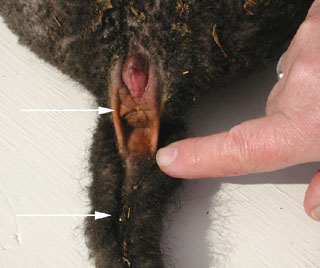
| The proper location for a tail dock. |
Introduction:
All lambs should be docked when they are 7 to 21 days old. Unless rams are to be kept for breeding purposes, they should also be castrated very early in life. With strong, vigorous lambs, both operations may be performed at the same time. When both operations are performed at the same time, castration should be done first. Clean all instruments and soak them in a disinfectant (chlorhexidine) for at least 10 minutes before beginning the procedure(s). Dip or soak the instruments in chlorhexidine between each docking. Each method of docking (knife, hot iron or electric dockers, Burdizzo, elastrator, emasculator, and All-In-One) will produce the same results if performed correctly. Restraint techniques can be found on C104.Docking and Tail Length:
The debate between leaving the tail full length or docking the tail at different levels is a continual discussion. A full length tail in the ewe will protect the udder from chilling. The tail and surrounding muscles also help prevent prolapses. However, if the tail is left long, soft feces collect under the tail, making an ideal site for fly strike. Flies lay eggs in and around the fecal mass, hatching into maggots that will attack the flesh under the tail and even enter the rectum and vagina. Long tails also interfere with the mating of breeding ewes. Docked lambs are cleaner and present a more uniform and sanitary appearance.On the other hand, completely removing the tail also has its problems. Some rectal and vaginal prolapses are genetic in origin, but many are the result of tail removal. The problem lies in the anatomy of the region. The anus and the vulva are held closed by sphincter muscles (circular muscles around these openings), which relax to allow feces and urine to be passed. These muscles have attachments to the underside of the tail bones. When a tail is docked short, some of the attachments are removed, thus weakening these muscles. The weakness may not be immediately apparent, but very often results in a prolapsed rectum or vagina.
Currently, it is recommended that the tail be docked just below the point of where the web (caudal fold) ends underneath the tail
. The arrows indicate a caudal fold and the tail. The finger indicates where the tail should be docked. Wether tails are cut much longer (in the West), principally because it is easier to distinguish wethers from ewe lambs in mixed groups. The recommendation to dock the tail even with the bottom of the vulva in ewe lambs and to below the rectum in the ram is a compromise between no dock and a complete dock. |
|
Six methods of docking are commonly practiced:
Knife: This is a commonly used method to dock tails. Only minor amounts of blood are lost if the tail is severed before extra fat is added to the tail region. This means that young, whitefaced lambs are the best candidates for this procedure. However, crossbred or smut-faced lambs can be docked with the knife method if they are under 4 weeks of age. To prevent excessive blood loss, the lamb must not be overheated. The person who does the docking may also twist the tail a quarter turn before using the knife. This allows an oblique cut across blood vessels and a chance for blood to clot more quickly than if a cut straight across them is made. Blood stop powders should also be used. In some cases, the blood vessels that are exposed should be pulled with a sterilized pair of hemostats.
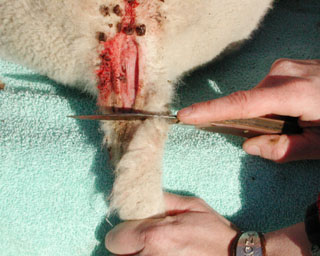 |
|
The wound made with this type of procedure tends to heal faster than with any
other method. This is very important in late season when the blowfly threatens
maggot infestation. It is also faster than any other mode of docking. However,
it is not aseptic and is particularly a risk when lambs are docked in dirty
corrals. Because of the significant bleeding that is sometimes associated with
this method, it is difficult to apply disinfectant or fly repellent so that it
will remain in the area.
All-In-One: This instrument functions on the same principle as a pocket
knife. It acts just like a pair of scissors and simply cuts the tail completely
off. If the edges of the instrument have been dulled, it can be very difficult
to completely sever the tail. Because it leaves a raw wound, it should not be
used on large lambs.
Burdizzo and Knife: This is the best method for docking older lambs that have big, fat tails. The Burdizzo crushes the tail, cutting off the blood supply. With the Burdizzo still in place, a knife is then used to cut the tail completely off below the crush. The Burdizzo closes the wound together and limits the amount of bleeding. It should be left on the tail at least 20 to 30 seconds before it is removed. Realize that the wound can be re-opened if the Burdizzo is removed carelessly from big lambs. If this happens, re-clamp the Burdizzo just above the open wound and leave it on for an additional 20 to 30 seconds.
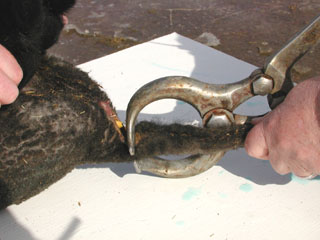 |
|
|
If the video
does not play, you must install an MPEG video |
Elastrator: The elastrator is a popular method with many sheep producers
because it is the only bloodless method. However, animals experience more pain
over a longer period of time with this method. It takes approximately 3 weeks
for the tail to finally atrophy and drop off. Tetanus is more of a problem when
the elastrator is used, and fly strike can also be a serious threat. Because of
the possibility of tetanus, all lambs should ideally receive a tetanus
vaccination before docking time.
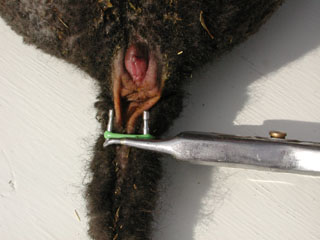 |
|
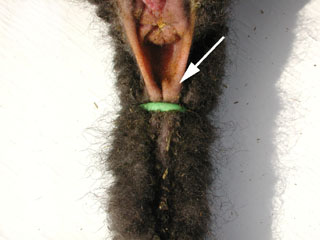 |
|
|
If the
video does not play, you must install an MPEG video |
Hot Iron or Electric Dockers: The hot iron or electric dockers are still
being used in many parts of the United States. Docking with this method is much
safer for most lambs. The electric dockers work similar to a pair of large
scissors, except they are electrically heated. As they sever the tail, the wound
is cauterized. The only drawback with electric dockers is the necessity of
having access to electricity. A hot iron can also be used to sever the tail and
cauterize the wound. The iron must be heated to a cherry red. If the iron is too
cold, it cannot cut through the tissue. Because the stress caused by these
methods is severe, they are not recommended for use on large lambs over 50
pounds. Lambs over 50 pounds should be docked with the Burdizzo.
When a tail is severed by a knife, there is one large blood vessel (plus others) that bleeds severely. If these vessels are stopped, there is little danger of the animal bleeding to death. This has lead to a docking method where the tail is cut off by knife and a hot iron is used to sear the blood vessels. This method is safe and results in fast healing, but it can also be very time consuming to perform.
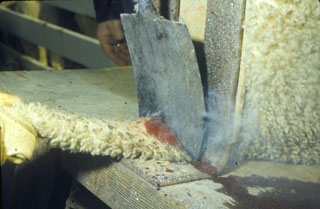 |
|
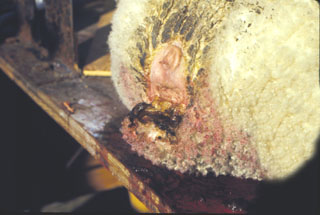 |
|
Emasculator: The emasculator is a veterinary instrument that cuts and
crushes at the same time. The docking operation tends to dull its cutting edges
quickly, resulting in frequent blade replacement. It also takes a great deal of
strength for the operator to use this instrument. Because of these reasons, the
emasculator should only be used on small lambs. For these same reasons, many
producers only use this instrument for castration. After the tail is cut, the
instrument should be left in place for 20-30 seconds to allow additional
crushing of the vessels to help prevent excessive blood loss.
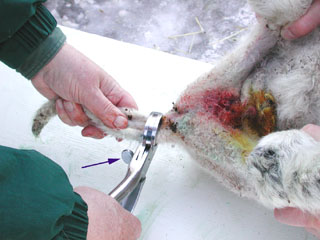 |
|
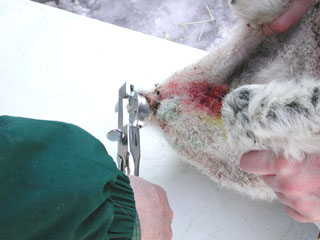 |
|